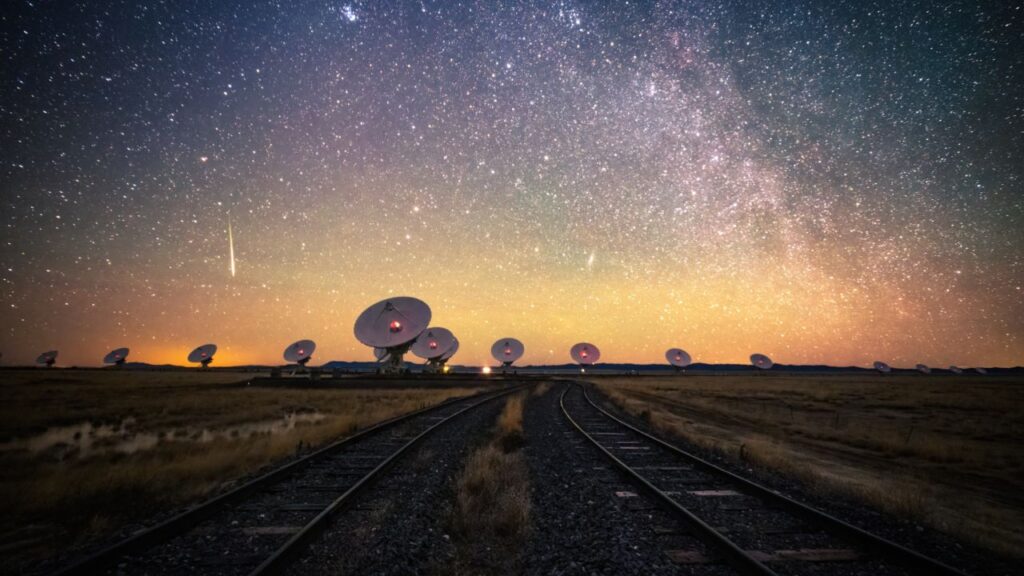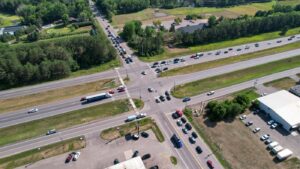
A new partnership between SpaceX and a team of American radio astronomers aims to protect radio telescopes worldwide from interference caused by satellites in low Earth orbit (LEO). This collaboration has led to the development of an automated data-sharing system designed to mitigate the disruptions that large satellite constellations, such as Starlink, create for astronomical observations.
As Starlink brings high-speed internet access to remote areas, it also poses challenges for optical and radio telescopes. These sensitive instruments are designed to detect faint radio waves emitted by distant cosmic phenomena, including black holes and neutron stars. Concerns have been raised by astronomers involved with the Square Kilometre Array Observatory (SKAO) in Australia and South Africa, who warn that interference from LEO satellites could obscure signals potentially indicating alien life and drown out radiation from the most distant galaxies.
Over the past three years, researchers from the National Radio Astronomy Observatory (NRAO) have been working closely with SpaceX to develop a solution. This system relays real-time information about scheduled telescope observations and the specific frequencies being used. When satellites approach observatories, the system instructs them to redirect their signals away from sensitive antennas or to mute their electronics altogether.
“The good news is that it’s autonomous on both sides,” explained Chris De Pree, deputy spectrum manager at the NRAO. “We are sending information in real time to SpaceX about what the telescope is doing, and their system digests it and issues commands to the satellites that are approaching the telescope.”
The collaboration includes two main components: the Operational Data Sharing (ODS) system, which sends observing schedules to Starlink, and the Telescope Boresight Avoidance algorithm, which directs the satellites to adjust their beams. This system has been successfully tested at the NRAO’s Very Large Array (VLA) in New Mexico since August 2024, with plans for further testing at additional sites, including the Very Long Baseline Array and the Green Bank Telescope in West Virginia.
The VLA, composed of 28 radio antennas each measuring 82 feet (25 meters) across, has made significant contributions to astrophysics since its construction in the 1970s. However, the deployment of the first Starlink satellites in 2019 raised alarms among astronomers, who recognized the potential for satellite megaconstellations to disrupt future observations.
“For decades, radio astronomers have been building telescopes at remote sites to avoid radio frequency interference,” De Pree noted. “With satellite constellations, there are now potentially thousands of sources of radio frequency interference directly above the telescopes.”
Cosmic radio waves, which travel across millions of light-years, are far weaker than the signals used for terrestrial communications, such as radio, television, and cellular networks. Consequently, sensitive radio telescopes require radio-quiet zones where broadcasting and wireless communication devices are prohibited. Unfortunately, satellites are not restricted from flying over these zones, impacting the effectiveness of these observatories. De Pree mentioned that hundreds of satellites pass over the VLA each day, stating, “Nowhere is remote anymore.”
The situation is expected to worsen, as the number of satellites has surged from approximately 3,000 in 2019 to over 15,000 today, with SpaceX planning to expand its Starlink fleet to more than 40,000 satellites in the next decade. Other companies, such as Amazon with its Project Kuiper, are also launching satellite services, potentially leading to a total of around 100,000 satellites orbiting Earth by 2030. This could significantly increase the interference faced by radio astronomers.
Understanding the urgency of the situation, the NRAO team initiated discussions with SpaceX in 2021 to find a workable solution. De Pree remarked, “Radio telescope electronics are very sensitive; they weren’t developed to handle such strong signals as the satellites produce.” The noise from these signals can affect not just the intended frequency ranges but also a broader portion of the radio spectrum.
In the 1950s, the International Telecommunication Union designated specific portions of the radio spectrum for radio astronomy, ensuring that no other users could transmit signals on those frequencies. However, satellite operators have increasingly encroached upon this reserved spectrum, making it challenging for astronomers to observe distant cosmic sources that emit radiation outside the protected bands.
“The challenge to radio astronomy is that a lot of these spectrum regions that used to be pretty quiet in the past are now being filled with transmissions,” De Pree explained. “As we start to lose more and more of those little chunks, the time we need to complete our observations goes up.”
Looking ahead, De Pree is optimistic that this new data-sharing system could be adapted for other major radio telescopes globally, fostering a cooperative environment between radio astronomy and satellite communications. By implementing this technology, both fields may coexist and continue to thrive in an increasingly crowded space.







